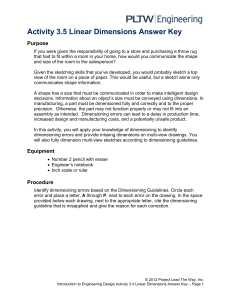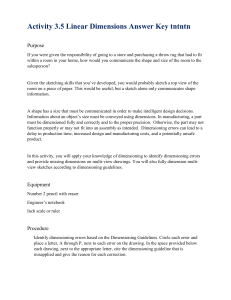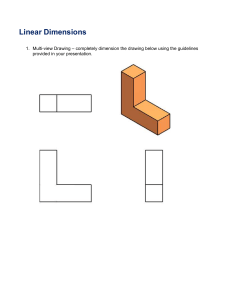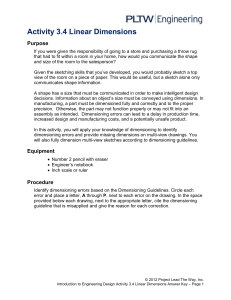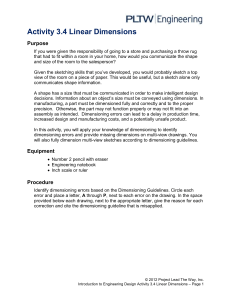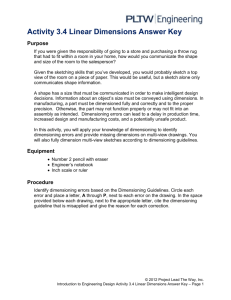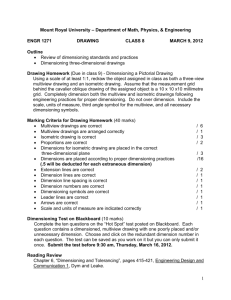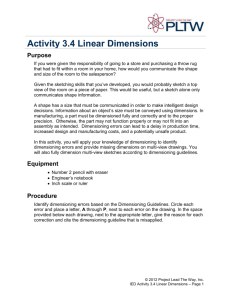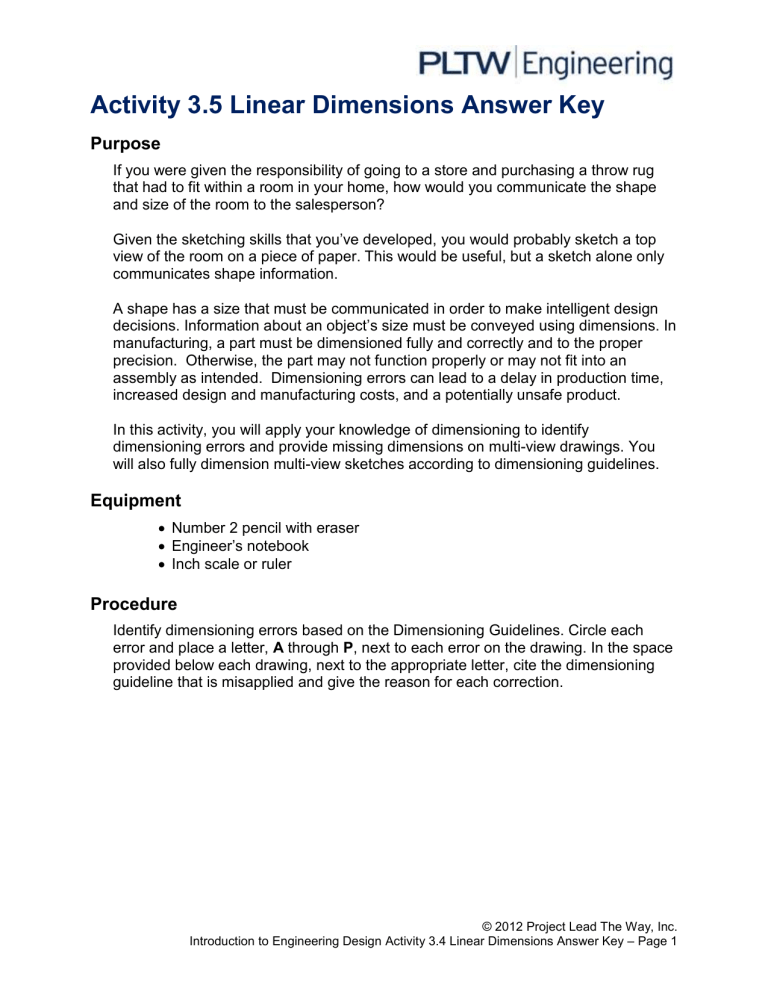
Activity 3.5 Linear Dimensions Answer Key Purpose If you were given the responsibility of going to a store and purchasing a throw rug that had to fit within a room in your home, how would you communicate the shape and size of the room to the salesperson? Given the sketching skills that you’ve developed, you would probably sketch a top view of the room on a piece of paper. This would be useful, but a sketch alone only communicates shape information. A shape has a size that must be communicated in order to make intelligent design decisions. Information about an object’s size must be conveyed using dimensions. In manufacturing, a part must be dimensioned fully and correctly and to the proper precision. Otherwise, the part may not function properly or may not fit into an assembly as intended. Dimensioning errors can lead to a delay in production time, increased design and manufacturing costs, and a potentially unsafe product. In this activity, you will apply your knowledge of dimensioning to identify dimensioning errors and provide missing dimensions on multi-view drawings. You will also fully dimension multi-view sketches according to dimensioning guidelines. Equipment Number 2 pencil with eraser Engineer’s notebook Inch scale or ruler Procedure Identify dimensioning errors based on the Dimensioning Guidelines. Circle each error and place a letter, A through P, next to each error on the drawing. In the space provided below each drawing, next to the appropriate letter, cite the dimensioning guideline that is misapplied and give the reason for each correction. © 2012 Project Lead The Way, Inc. Introduction to Engineering Design Activity 3.4 Linear Dimensions Answer Key – Page 1 Reason A. Double-dimension; wrong side, NO SPACE between extension line and corner C. Unnecessary dimension; wrong side,NO SPACE between extension line and corner Reason B. Double-dimension; wrong side D. Double-dimension; wrong side © 2012 Project Lead The Way, Inc. Introduction to Engineering Design Activity 3.4 Linear Dimensions Answer Key – Page 2 Reason E. Dimensioned to hidden line; better on top view where contour of feature is shown Reason F. Unnecessary dimension; (wrong side – place between views); (better on front view where contour of feature is shown) © 2012 Project Lead The Way, Inc. Introduction to Engineering Design Activity 3.4 Linear Dimensions Answer Key – Page 3 G. Better on top view where contour of feature is shown; (wrong side) H. Need a dimension for one or the other can’t assume they are supposed to be both 0.5, so you need dimension only one of them Reason Reason J. Fillet radius not shown K. Location of holes not shown L. Never give overall height M. Round radius not shown N. Better in adjacent views Note: “2 x” could be used in the dimension of the holes on the top view in lieu of dimensioning both. © 2012 Project Lead The Way, Inc. Introduction to Engineering Design Activity 3.4 Linear Dimensions Answer Key – Page 4 © 2012 Project Lead The Way, Inc. Introduction to Engineering Design Activity 3.4 Linear Dimensions Answer Key – Page 5 4. Sketch an isometric view of the object. Then dimension the orthographic projections. Line spacing on the grid equals 0.125 in. 5. Sketch an isometric pictorial of the object. Then dimension the orthographic projections. Line spacing on the grid equals 4 mm. © 2012 Project Lead The Way, Inc. Introduction to Engineering Design Activity 3.4 Linear Dimensions Answer Key – Page 6 6. In your notebook, create a fully dimensioned multi-view drawing for the following puzzle cube piece. Assume that the puzzle cube piece is made up of six ¾ in. cubes. © 2012 Project Lead The Way, Inc. Introduction to Engineering Design Activity 3.4 Linear Dimensions Answer Key – Page 7 7. Create a fully dimensioned multi-view drawing for the object below. The length of each grid segment on the isometric paper is 3 cm. © 2012 Project Lead The Way, Inc. Introduction to Engineering Design Activity 3.4 Linear Dimensions Answer Key – Page 8 Conclusion 1. Why is placement of your dimensions so important? So they are easy to read, so they look neat and orderly, so you following the same procedures as everyone else. If everyone has their own language then no one would understand each other. Same with dimensional rules. If everyone had their own dimensional rules no one would understand each other’s work 2. Why do designers need to fully dimension a part? So it can be built or manufactur the exact way they want it. If not they would have to guess what the dimensions are and it would not come out exactly the way the designer wanted it 3. What does it mean when a sketch is over dimensioned? It means they duplicated dimensions. Or put dimensions that were not neaded © 2012 Project Lead The Way, Inc. Introduction to Engineering Design Activity 3.4 Linear Dimensions Answer Key – Page 9
